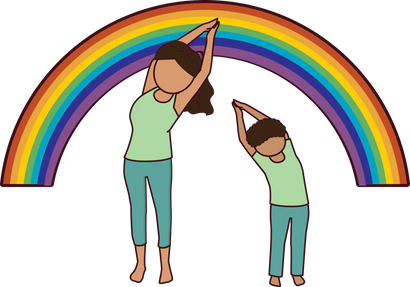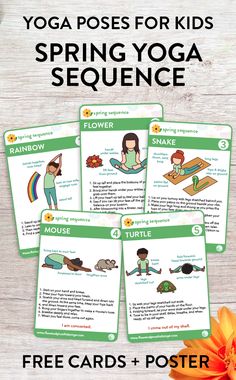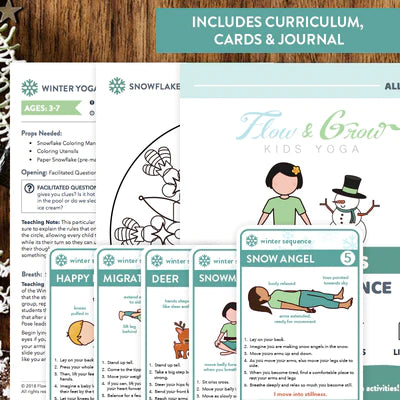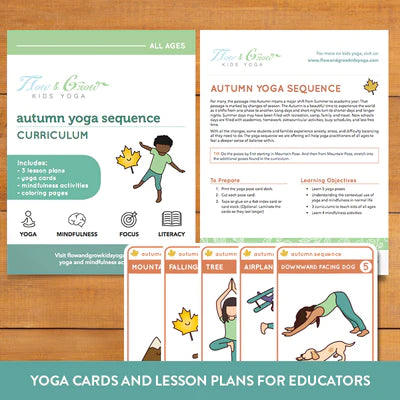Your Cart is Empty

What Does Springtime Have to Do with Yoga Philosophy? -- Yoga for Spring Part I
by Lara Hocheiser March 05, 2021 6 min read
Spring comes with spring cleaning. As adults, we may or may not enjoy the process of cleaning out and cleaning up -- but mmmm, aaaah, don’t we love that feeling of getting rid of things we don’t need and clean, clear spaces! Think of how popular Marie Kondo andThe Home Edit have become.
Children, tweens, and teens may really struggle getting rid of the old with a big spring clean because of emotional attachment to possessions. They may be uncomfortable or resistant to saying goodbye to clothes that don’t fit anymore and toys they haven’t played with in a while. Yoga philosophy is here to help! Adults can also suffer from hoarding behaviors and attachment to “things” (and guess what, yoga philosophy can HELP them, a lot!).

Practices like getting rid of what we don’t need can feel daunting -- but the relief we feel mentally with a clean, clear area and the joy of giving to those in need who can receive our possessions can reward us. The idea of letting go also connects with being able to transition to new activities with calm and joy, as well; as we transition through our days, we need to let go of the old and say a cheery hello to the new.
Children in particular can find that transitioning difficult, but it shows up in people of all ages in different ways. Just as we welcome a new season of rebirth, growth, and new light in spring, we can welcome in new activities as the clock ticks on. Yoga philosophical practices that come from the yamas and niyamas can guide us here. They aresauca (cleanliness) andaparigraha(non-attachment), as well a kind of yoga calledkarma -- the yoga of selfless service (we’ll circle back to that).
Parents might also notice that their young ones are having a more difficult time falling and staying asleep in the spring -- while wake-up time may creep earlier and earlier, too! Acknowledge the changing of seasons, sleep cycles, and the need to clean, calm, and perhaps reorganize your day! Let’s practice some yoga and yoga philosophy to make this all a little easier on us.
Mindful Spring Cleaning
- Set aside a time to clear out your child’s bedroom or playspace, ideally a time that won’t come with a rush or distractions -- if at all possible. Create a peaceful atmosphere; perhaps light a candle with a calming scent (such as lavender) and some tranquil background music. At any point through the spring cleaning, if you notice that your child, or yourself, could use an energy boost, you can switch to some more upbeat music. Energetic “tunes” can make cleaning more fun and make the task go by in no time at all!
-
Take a moment to talk openly with your child. In language that’s accessible and appealing to them, explain the yogic concept ofsaucha-- that cleanliness (of our bodies, of our spaces, and of our wider environments) helps us to focus and contributes to our overall health and well-being. Ask them, as an example, is it easier to focus on studying and schoolwork when their room is clean or when it’s messy? If your child is too young for that example to resonate, try to think of another one that you think will (from your intimate knowledge of them as people). Additionally, letting go of things they don’t need isaparigraha-- or non-attachment -- in practice, which can bringsantoshaor contentment. Aaaah, letting go feels so good!

- Set up four spaces -- labeling them, if possible, to avoid confusion: to keep, to donate, to recycle, to put in the trash. Regarding donation, note to your child that it’s not only kind to give away things we don’t need to the less fortunate than us, it feels good for us too! This is karmayoga, or the yoga of selfless service. This can additionally begin to inform your child on social issues and institutions such as poverty, philanthropy/charity, and organizations that serve the less-fortunate. Keeping recycling in mind can attune your child to environmental issues and the importance of the three Rs: reduce, reuse recycle. You can even make a note of how much plastic is in the things they own. Could they make changes there going forward?
-
Begin the sorting! Go through your child’s possessions together, one by one, putting each in one of the piles. If they’re having trouble letting go of things that you, as their parent, are well aware that they don’t regularly use, it’s time for more open talk. Ask them if another child who’s less fortunate could make better use of the thing or things they’re having trouble letting go, and remind them of the value of sharing. With things that can just be thrown away, remind them how they can focus better -- and maybe evenfeelbetter -- in more clean, clear spaces. Isn’t that more valuable than holding on to things that they rarely or never use? And if a child is really attached to things, do not force them to donate anything. Allow them to consider it. (You can always disappear items when they aren’t home. They almost never notice if the things were truly not used. This is sneaky, but many parents have to do this if the child is severely attached to items they can not use, and if that’s the case, you may need to seek mental health support for them.)

- Once everything is sorted, bag up and carry out the piles as necessary -- the trash to the trash, recycling to the recycling, and “to donate” in a space where it’ll be convenient to take to the closest homeless shelter, food kitchen, or Salvation Army (be sure to check with the institution that you’re bringing the donated items before you go -- they sometimes have guidelines for donating). Vacuum or wipe up any dust or debris that might have accumulated through the sorting. Be sure that your child helps; cleaning is a life skill best learned early!
- Finally, put on finishing touches by organizing the space in a clean, clear way that appeals to the child and seems practical to move about the space.
- You and your child did it! Congratulate them and tell them that you’re proud. Take a few deep breaths together and -- in the idea of modeling -- note how good it feels to have a cleaner, cleared-out space. Perhaps you can also enjoy a healthy treat together after all of that hard work!
5 Breath Space Maker
This activity can be helpful for parents, educators, and anyone who works with children/youth.
This exercise is a great way to make transitioning from one activity to another, which can be challenging for children and youth, more peaceful and joyful. The Earth welcomes in a new season of growth, rebirth, and more light in the spring, and we can do the same as we transition to new activities -- waving goodbye to an activity and a happy “hello” to another. As might be accessible, age-appropriate, and organic in the context of conversation, you can even tell the young ones in your life that! For the longer-term, you can also print out this poster and hang it in your child’s bedroom as a guide and reminder!

Yoga for More Restful Sleep
Similarly, those in preschools or childcare centers, others who care for children, and parents can all use the following to help the young ones in our lives more restful sleep.
Children and youth don’t only have sleep issues in the spring, yet the sun setting later in the day can make getting and staying asleep difficult. Wake-up times can’t necessarily fall later in the day, given when things start in the morning -- and the sun also rising earlier in the morning could make sleeping later challenging anyways. With the sun up later and earlier, there may be less sleep on both ends of the day!
OurBedtime Yoga Coloring Book and Cards andMy Yoga Workbook: Mindful Bedtime Habits are guides in yoga and other mindful activities leading up to bedtime. That can help instill the feeling of calm and ease that makes falling and staying asleep easier. Transitioning amongst the activities of the day with more calm through the 5 Breath Space Maker, and a cleaner, clearer space from Mindful Spring Cleaning, can help create even more ease and calm!
Particularly in a time of year when more daylight can make sleep more difficult for the children/youth in your life, it’s important to not forget basic sleep hygiene principles.. Put away screens an hour or two before bedtime, and keep physical activity -- as much as possible -- no later in the day than the early evening. Include a regular calming activity in bedtime routine, such as reading together or a bath. Keep bedtimes and wake-up times regular. A comfortably cool room is best for sleep.
Adequate sleep is essential for children, tweens, and teens, to do and feel their best, in the spring and all year long. Yoga, mindfulness, and mindfulness-informed principles can help!

We also have guides for yoga philosophy for bothteens/tweens and ages7-11. Buy both in thisbundle!
Leave a comment
Comments will be approved before showing up.
Also in Kids Yoga Blog

Fun & Educational Yoga Stories for Preschoolers: Movement and Imagination
by Lara Hocheiser April 28, 2024 3 min read

Easter Yoga Poses for Kids: Joy and Wellness to the Holiday Season
by Lara Hocheiser April 04, 2024 4 min read

Multifaceted Health Benefits of Yoga for Kids
by Lara Hocheiser February 04, 2024 3 min read
Yoga for kids has a transformative power! Holistic practices can enhance mental health, concentration, and physical fitness.
Yamas and Niyamas: Successful Relationships with Self & Others (tweens and teens)
digital-resourceskids-yoga-resourceslesson-plansmiddle-high-school-yoga-mindfulnessmindfulnesspricey-content
Yamas and Niyamas: Successful Relationships with Self & Others (tweens and teens)
2 reviews
5.0 / 5.0
(2) 2 total reviews
$55.00
Yamas and Niyamas: Successful Relationships with Self & Others (tweens and teens)
2 reviews
5.0 / 5.0
(2) 2 total reviews
$55.00
Ultimate Kids Year of Yoga Bundle
bundlesdigital-resourcesearly-childhood-yoga-mindfulnesselementary-yoga-mindfulnesskids-yoga-resourcesmiddle-high-school-yoga-mindfulnesspricey-contentseasonal-yogayoga-cards
Ultimate Kids Year of Yoga Bundle
5 reviews
5.0 / 5.0
(5) 5 total reviews
$45.00
Ultimate Kids Year of Yoga Bundle
5 reviews
5.0 / 5.0
(5) 5 total reviews
$45.00
Kid’s Sun Salutation Yoga Cards
digital-resourcesearly-childhood-yoga-mindfulnesselementary-yoga-mindfulnesskids-yoga-resourcesliteracyunder-15yoga-cards
Kid’s Sun Salutation Yoga Cards
3 reviews
4.33 / 5.0
(3) 3 total reviews
$12.95
Kid’s Sun Salutation Yoga Cards
3 reviews
4.33 / 5.0
(3) 3 total reviews
$12.95

















